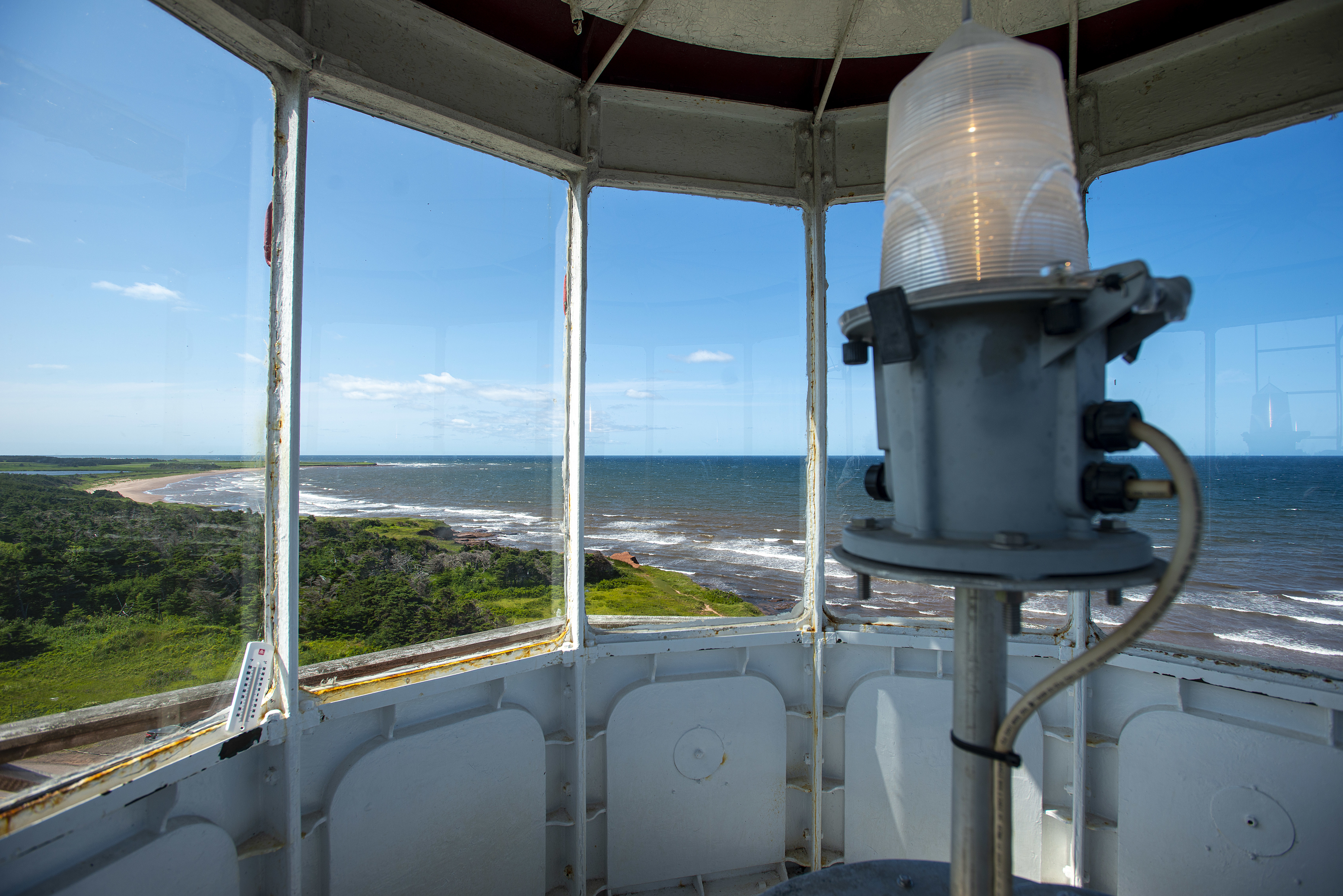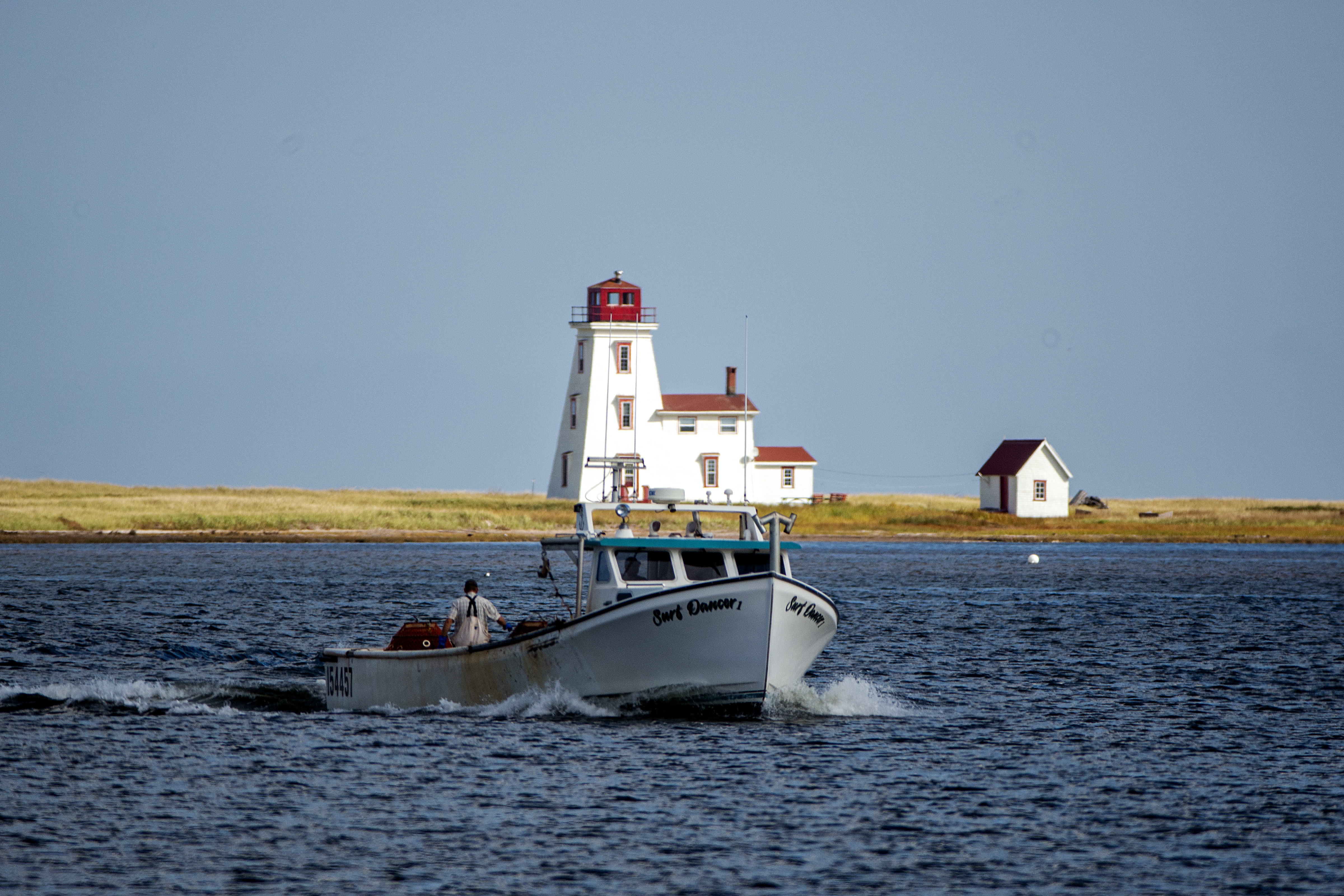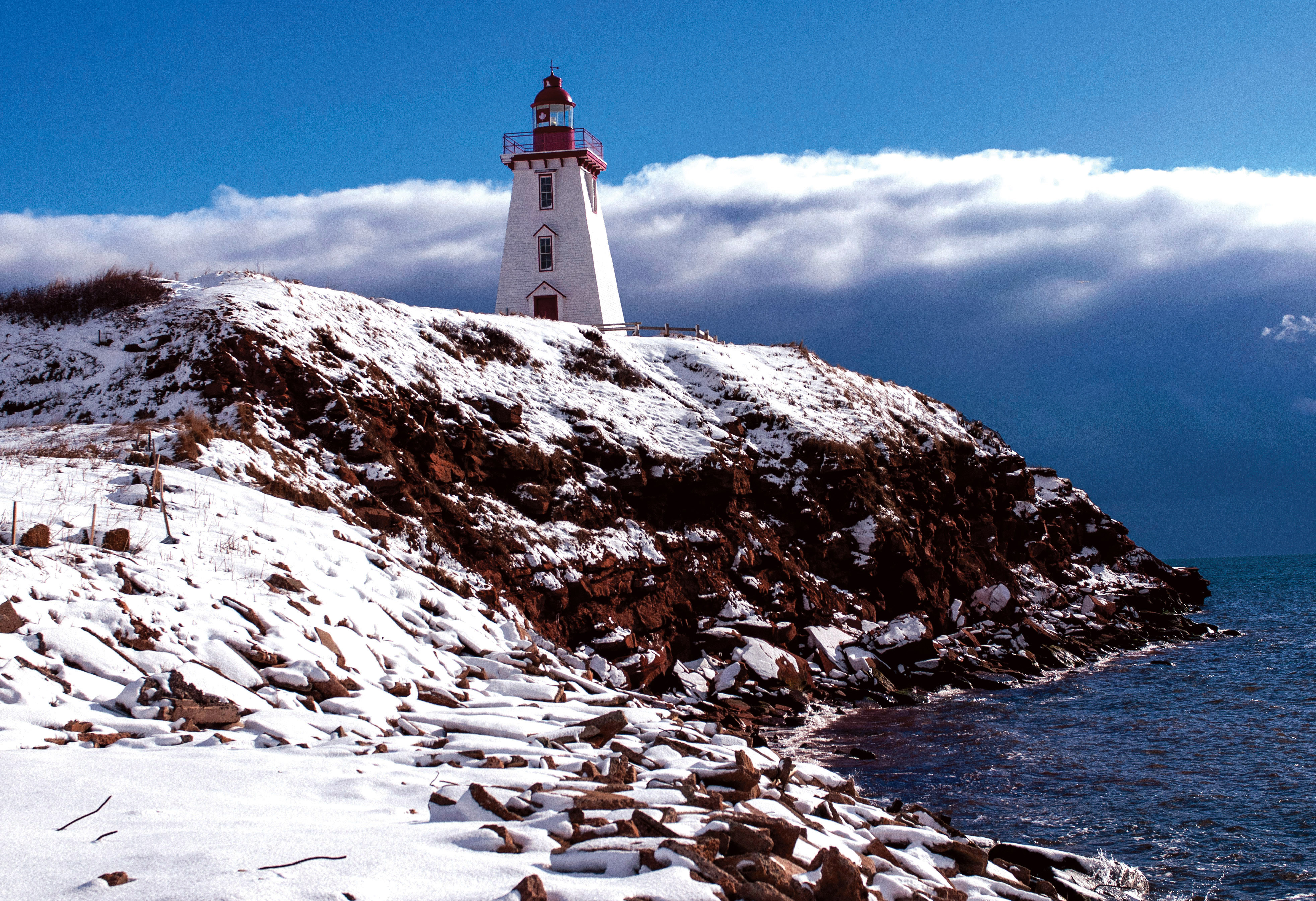August 22, 2020
Lighthouses are a thing of romantic beauty for me, as they are for many people, and I come by this honestly.
When I was a youngster growing up in Charlottetown in the mid-1950s and 1960s, I remember visiting the East Point light with my family on many occasions because the keeper at the time was either a distant relative of my father or maybe a family friend. I have never really determined the connection, but what I do remember is climbing the many steps up to the lantern and walking out onto the lantern deck.
I can’t recall if I was scared, but since my visits to East Point I have walked on the lantern deck of other lights and have certainly gotten as far as the lantern, which is the enclosure that protects the lens and lamp and is the top portion of the lighthouse from the deck up.
There are 63 lights dotting the coast of Prince Edward Island and except for a few, they are all accessible to the public. Some are owned and maintained by community groups, but others are still owned by the Canadian Coast Guard and some are not in the best repair. All are automated and none are staffed.
The ones like East Point, Point Prim, Wood Islands and Panmure Island are owned by local groups and open to the public and they all offer a fantastic glimpse into P.E.I.’s maritime past. A few others have been turned into summer homes, but they still maintain the facade of a lighthouse.
Since I have a special interest in the lights and being a photographer, I have made it one of my personal assignments to photograph all of them and I am getting close.
When I was photographing Panmure Island’s light, I was chatting with one of the volunteers looking after the light and gift shop and she said she and some other volunteers once rode out a storm high up in the lantern. It gave them a much better understanding of what the keepers endured all those years ago.

The Cape Tryon Lighthouse was built in 1965 to replace the original that was built in 1905.
That light was one of the Island lighthouses that remained in service year-round from 1943-1945 to aid wartime pilots training at the British Commonwealth Air Training Schools.
The interior of the current building is unfinished; it has always been electrified so has never had a dwelling for a keeper.

The most eastern tip of P.E.I. and the surrounding coastline is laid out for all to see from the lantern of the East Point Lighthouse.
It was built in 1866-67 and is a major coastal light that serves all marine traffic using the Canso Strait to the Gulf of St. Lawrence. Because of its location at the extreme eastern tip of the Island, there is glass all around the lantern, allowing the light to be seen for 360 degrees.
It is constructed with heavy hewn timber with a shingled exterior. It has a well-proportioned fascia at the top of the tower and a cross-braced wooden railing. The windows and door are topped by triangular pediments trimmed red.
The interior has three landings and 67 steps. It’s the last of the colonial era lighthouses to be built on P.E.I.

The former Cascumpec Lighthouse that today is located on the Cascumpec Sand Hills was built in 1876 to replace another light on what is known as Cum’s Sandhills, located across the Alberton Harbour from the Cascumpec Sand Hills.
But in 1899-1900, the lighthouse had to be moved across the harbour ice to the Cascumpec Sand Hills, where it stands today. The move took 16 teams of horses to accomplish, but it got stuck in snow drifts on the sandy island and it remains today in the same spot where it got stuck.
Many years ago, the light and the sand island on which it sits was sold to a family in Charlottetown who still own it.
Before the light was decommissioned years ago, it guided boats and ships into Alberton Harbour. It was electrified and destaffed in 1968.

The Howard's Cove/Seal Point Lighthouse certainly is not the prettiest on Prince Edward Island, but it is one of the smallest. It was built in 1978 to replace a light erected in 1960.
“It is a wooden, square pyramidal tower topped by an enclosed lantern open on the two seaward sides," according to the P.E.I. Lighthouse Society.
"The lantern deck is surmounted on the tower and surrounded by a metal railing which is supported by metal brackets. There are large pediments over the window and door. It is covered with cedar shingles painted white with red trim.”

The New London Lighthouse was built in 1876 to help guide ships into New London Bay. It was constructed for $1,300 by George MacKenzie, who became the keeper of the light for 20 years.
In 1894, he saved the lighthouse from being razed in a fire by entering the lantern room, which was engulfed in flames, and extinguishing them.
For almost 40 years, the lighthouse was rented out as a summer home, but that was discontinued 20 years ago when the Canadian Coast Guard stopped private leasing of Prince Edward Island lighthouses.
The electricity was removed in 2009, but a solar-powered light continues to provide guidance. The light stands not far from the Yankee Hill cemetery that contains the bodies of many victims of the Yankee Gale of 1851.

A lighthouse still guides boats into the North Rustico Harbour as has been the case since the 1800s.
According to the P.E.I. Lighthouse Society, “the light was designed by the Department of Marine and was built in 1876. It was undermined and capsized during a gale on January 12, 1899. It was then moved back and rebuilt as a coastal light. It was moved again in 1914. A new foundation was installed in 1954. It was damaged during a 2009 storm surge.”
The light was destaffed in 1960 and a new tower was built in 1973, but strong public pressure led to the re-establishment of the old tower in 1976.

The Panmure Island Lighthouse was the first wooden lighthouse built on Prince Edward Island and was constructed in the octagonal heavy-timber-frame-style typical of the pre-Confederation lighthouses on P.E.I., says the P.E.I. Lighthouse Society’s website.
“When the lighthouse was built in 1853, Panmure Island was a sand hill, not connected by a narrow isthmus as it is today."
The lighthouse guided shipping to Georgetown and Montague as it still does today.
The horses belong to a neighbouring farm and roam the field adjacent to the lighthouse. It was electrified in 1958 and was destaffed in 1985 when it became automated.

Souris is one of only three lighthouses on Prince Edward Island that have telecommunications equipment to direct air and sea traffic throughout the Gulf of St. Lawrence. The others are North Cape and Cape Egmont.
The wooden tower was constructed in 1880 and an attached dwelling was built in 1881. The light was electrified in 1961 and destaffed in 1991 and is a major coastal light that guides the Magdalen Islands ferry as well as other shipping in and out of Souris harbour and along the coast.

According to the P.E.I. Lighthouse Society’s web page, range lights were established in the St. Peters Harbour area in 1865, but the exact date of the lighthouse construction is unknown.
This is one of the 16 locations in Prince Edward Island that had lights when the province joined Confederation in 1873.
West Point Lighthouse was built in 1875 and was the first of the square tapered towers on P.E.I.; because St. Peters Harbour Lighthouse is built in that style, it would have been built after this date.
The remains of an old wharf can be seen in the photo.

The Wood Islands Lighthouse near the NFL ferry terminal was built in 1875, electrified in 1958 and destaffed in 1990.
It was the second lighthouse built after Prince Edward Island came under the control of the Federal Department of Marine and Fisheries in 1873.
It was recognized as a federal heritage building in 1992 and was moved inland 70 metres in 2009 because of erosion.
The Wood Islands Area Development Corporation opened the lighthouse in 1998 and there are 11 rooms of displays as well as a gift shop.

The Brighton Beach front range (Victoria Park) was built in 1889-1890 and along with a second pair of range lights “helped mariners navigate a 30-foot channel through Hillsborough Bay and into Charlottetown Harbour,” according to the P.E.I. Lighthouse Society.
In the winter of 2000, it was severely damaged during a storm surge. During repair work, the top six metres was removed while the lower 3.6 metres was demolished and rebuilt from the ground up. The top was then reattached.
It became the first P.E.I. lighthouse to receive designation under the Heritage Lighthouse Protection Act and in 2013 ownership of the light was transferred from the federal government to the City of Charlottetown, which is now responsible for its upkeep.

The light to the entrance of Covehead Harbour was built in 1975 and is one of the newer P.E.I. lights.
It has always been electrified and has never had a keeper.
It features a 100-year-old bull's eye Fresnel lens that was formerly used at Dalhousie, N.B.

The light was built in 1881 and was the first Canadian land station to receive the distress signal from the Titanic as it was sinking in the North Atlantic on April 14, 1912 (Newfoundland was not then part of Canada).
During the Second World War, the Cape Bear Lighthouse proved useful for spotting German U-boats that neared the coast; several were seen along the shore but disappeared while being tracked, notes the P.E.I. Lighthouse Society’s web page.
Because of erosion of the sandstone cliffs, it was moved to an adjacent property in 2015 and is now safe from falling into the sea — at least for now. The light was electrified in 1960 and destaffed that year; it was decommissioned in 2011.
In 2012, it was recognized as a heritage place under the Prince Edward Island Heritage Places Protection Act.

This is the keeper’s parlour of the West Point Lighthouse as it might have looked around 1900. It is located within the Island's tallest lighthouse, standing on a sandy beach at the tip of West Point where the waters of the Northumberland Strait and Egmont Bay meet.
Measuring 20.7 meters tall, it was built in 1875, and electrified and destaffed in 1963.
It remains a working lighthouse, but due to its location it has to be protected from gales and storm surges, so a seawall was built in 2011 to help protect it.

The Indian Head Lighthouse at the entrance to Summerside Harbour was built in 1881 and “has one of the most unique shapes of any Prince Edward Island lighthouse,” says the P.E.I. Lighthouse Society.
It also makes for a beautiful photograph in the late afternoon winter sun.
“It is completely octagonal from the concrete base to the lantern. The keeper's dwelling is at the base, and a tower and lantern rise from the centre of the dwelling's roof. The dwelling has 12-foot sides and an inside diameter of 26.5 feet. The tower has sides five feet wide with an inside diameter of 10 feet. There is a wooden railing at both the gallery and dwelling level,” according to the society's website.
Keepers rowed a small boat out from Summerside in the late afternoon, spent the night and rowed back to land in the morning, the society notes.

This light would be a familiar sight to anyone who travelled on the ferries between P.E.I. and Cape Tormentine.
It was built in 1925 to guide the car ferries into Port Borden.
When the Confederation Bridge was opened in 1997, the pier was purchased by a fish packing company that has built a factory there, so access to the lighthouse is restricted.

Built in 1845, Point Prim is the oldest lighthouse on Prince Edward Island.
It went into service in 1845 and is located at the southeastern entrance to Hillsborough Bay, at the outer approach to the Charlottetown Harbour.
The lighthouse protects marine traffic from the extensive reefs at the entrance to the bay and points the way into Charlottetown Harbour.
The light was electrified in 1955 and destaffed in 1969.

At dawn, the Blockhouse Point Lighthouse is in a beautiful setting. The present building was built in 1876 as the outer light for the Charlottetown Harbour.
It was automated in 1962 and destaffed in 1963.
“The flat roofed dwelling is very unusual on Prince Edward Island. It has one of the most spacious dwellings of all of the Island lighthouses. The ground floor of the dwelling was designed with a kitchen, a parlour, and two bedrooms. The second floor has four more bedrooms and a smaller room which was used as a bathroom,” according to the P.E.I. Lighthouse Society. (Brian McInnis/CBC)

The North Cape Lighthouse was built in 1865 and went into service in 1866. It is one of three “sister lights” built immediately before or after Confederation.
The others are at Seacow Head, P.E.I., and Cape Jourimain, N.B., and are among the oldest wooden frame light towers still standing in the Maritimes.
North Cape is one of three Island lighthouses that have telecommunications equipment to guide air and sea traffic throughout the Gulf of St. Lawrence.
It was built primarily to warn mariners away from the longest rock reef in North America, lurking not too far off shore.
